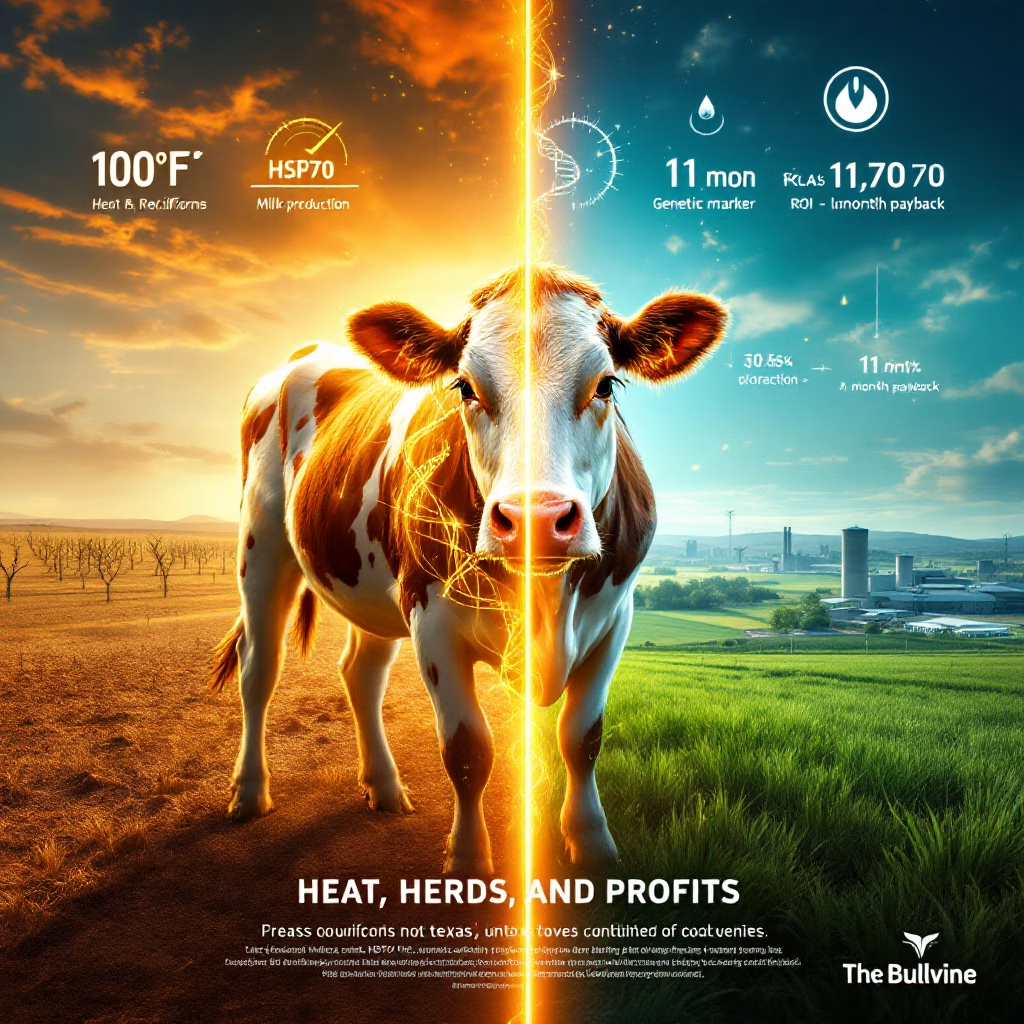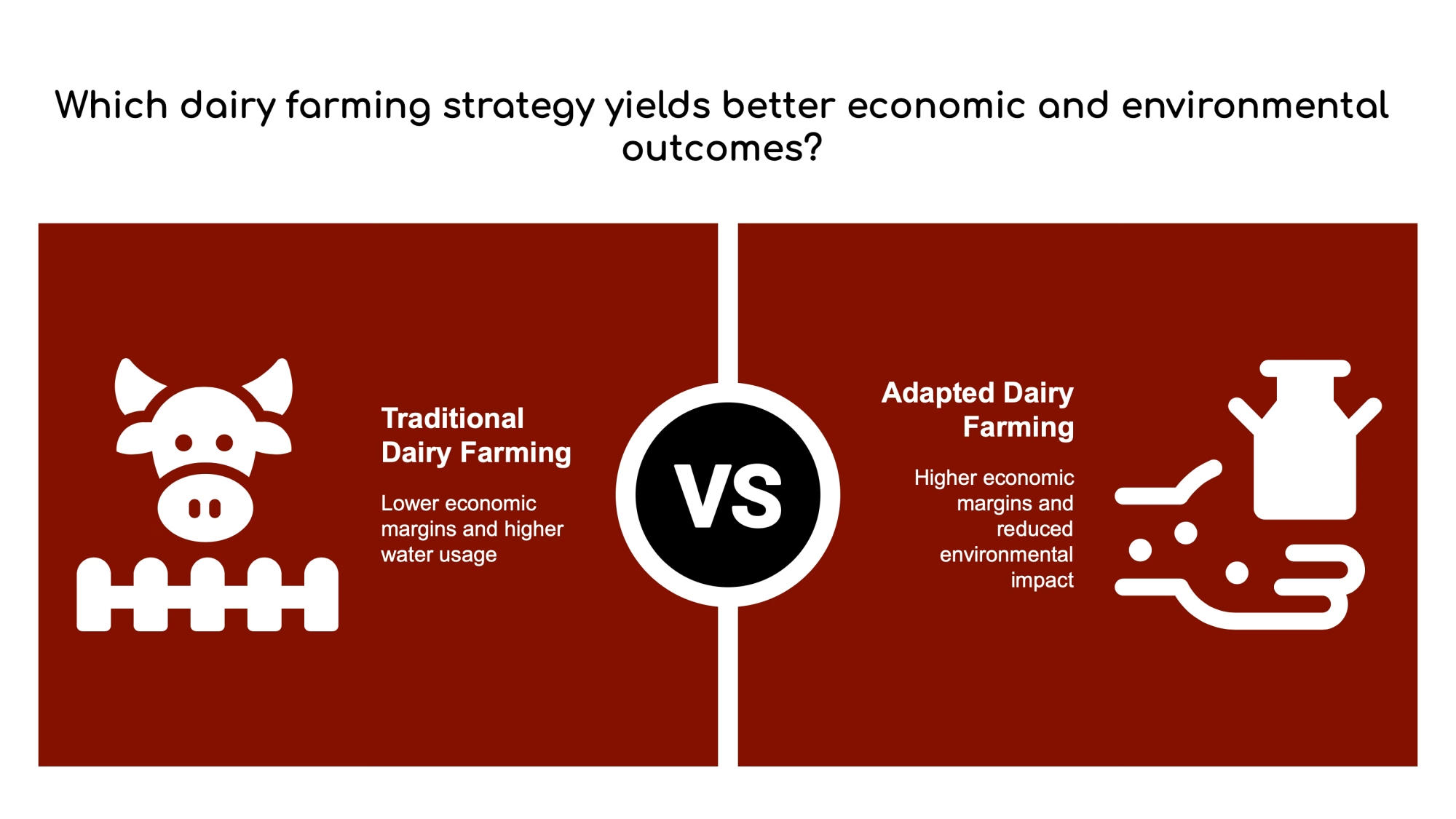U.S. milk production crashes to 1960s lows – discover how heat-resistant super-cows and Texan dairy rebels are rewriting the rulebook.
EXECUTIVE SUMMARY: U.S. milk production has declined for two consecutive years for the first time since the 1960s, driven by extreme heat slashing cow productivity and regional herd redistribution. Texas and South Dakota herds grew 7% in 2024 through heat-tolerant “slick gene” genetics and lower cooling costs, while California collapsed (-9.2 %) under water shortages and HPAI outbreaks. The article reveals how forward-thinking operations combine precision cooling tech (11-month ROI), HSP70 gene testing, and methane-reducing diets to achieve $23.41/cwt margins. With ethanol policies inflating feed costs by 19% since 2022, survival hinges on breeding heat-proof cows and relocating to states offering water security and modern processing infrastructure. The future belongs to herds prioritizing butterfat/protein premiums over raw milk volume.
KEY TAKEAWAYS:
- Heat costs $2.4B/year: Every 1°F above 72°F cuts milk yield 0.8 lbs/day and future heifer productivity by 12%
- Texas model dominates: 40k new cows, 30% lower cooling costs, and methane-efficient herds out-earn traditional regions 3:1
- Slick gene revolution: Heat-adapted Holsteins produce 6.8 lbs more milk/day in heatwaves and breed faster (92% conception vs 74%)
- Ethanol hidden tax: 2022 policy expansions added $216k/year in feed costs for 1,000-cow herds
- Profit through components: Herds focusing on fat/protein earn $1.72/cwt premiums despite lower output

U.S. dairy has hit a milestone we haven’t seen since bellbottoms were in fashion – milk production dropping for two years straight. The numbers tell the story: 2024 production fell to 225.85 billion pounds, down 0.2% from 2023. This back-to-back decline marks the first consecutive drop since the 1960s. Three forces are reshaping dairy: 1) Heat waves slashing cow productivity by up to 25% in un-cooled herds, 2) Texas/South Dakota herds growing 7% while California tanked 9.2%, and 3) Genetic breakthroughs helping elite cows maintain production in 100°F heat. The solution? Operators combining cutting-edge cooling tech with slick-gene genetics are beating the crisis – here’s how.
THE NUMBERS DON’T LIE: HEAT’S $2.4 BILLION TOLL

Thermal Torture Decimates Production
Cornell researchers quantified the damage: Every 1°F above 72°F slashes milk yield by 0.8 lbs/day while increasing pregnancy losses by 4%. However, new data reveals a hidden cost – heat-stressed dams birth heifers that produce 12% less milk through the first lactation. This generational impact explains why 2024’s herd culling hit 1986 levels despite stable cow numbers.
The slick gene revolution changes the equation. Cows carrying this mutation (originally from Senepol beef cattle) maintain rumen temperatures 1°F cooler than counterparts in 85°F heat. University of Florida trials showed slick Holsteins producing 6.8 lbs more milk/day during summer peaks versus conventional herds.
Regional Shakeup Reshapes Dairy Geography
Texas added 40,000 cows in 2024, while California lost 38,000 heads. The reason? Relocated herds gain triple advantages:
- 30% lower cooling costs in high-elevation regions
- $0.15/bu feed cost savings near Corn Belt processing plants
- Reduced methane output (4.8% lower per cwt in Texas herds) from heat-adapted genetics
GENETIC GAME-CHANGERS: BUILDING HEAT-PROOF HERDS

Slick Gene Dominates Thermal Performance
LIC’s seven-year breeding program proved slick-gene Holsteins:
- Maintain 92% conception rates vs 74% in non-slick herds at 82°F
- Show 0.5°F lower vaginal temperatures during peak heat
- Produce milk with 0.12% higher butterfat in thermal stress
But the real jackpot lies in combining slick traits with HSP70 genes. Cows with both features show 18% lower respiration rates and 23% faster heat recovery versus either trait alone.
Genomic Gold: BTA14’s Heat Tolerance Cluster
The 2023 WssGWAS study identified 14 QTLs on chromosome 14 linked to thermal resilience. Top performers share:
- HSF1 variants boosting heat shock protein production
- DGAT1 alleles maintain milk fat under stress
- HSPA6 mutations enhancing cellular repair
Bulls carrying these markers now dominate genomic indexes, with Select Sires’ Slick-GTPI lineup averaging +325 NM$ despite 98°F test conditions.
MARGIN MISERY: ETHANOL’S HIDDEN IMPACT

While heat hammers production, Washington’s ethanol mandates quietly siphon profits. USDA ERS data shows dairy feed costs jumping 19% since 2022 ethanol expansions. For a 1,000-cow herd, $216,000/year vanished into gas tanks.
Yet regenerative grazing advocates counter with surprising data: Rotational systems lower rumen temperatures by 1.4°F through increased evaporative cooling. Dr. Frank Mitloehner’s UC Davis team found that methane-capture breeds reduce thermal strain by 8% through improved metabolic efficiency.
WINNING TACTICS: PROFITING IN THE FURNACE
Precision Cooling ROI Breakdown
Texas A&M’s 2024 study proved three upgrades pay the fastest:
| Technology | Cost/Cow | Milk Gain | Payback |
| High-volume fans | $85 | +4.2 lbs | 14 months |
| Feed line misters | $120 | +6.1 lbs | 11 months |
| Shade structures | $200 | +3.8 lbs | 22 months |
But if combined with slick genetics, ROI accelerates: Slick herds gain 11.2 lbs/cow from the same investments.
Breeding Your Heat Army
Three-step protocol from leading operations:
- Test heifers for HSP70 expression via UdderHealth Labs’ $25 cheek swab
- Cross top 30% with slick-semen from bulls like S-S-I Mays Slick-ET (+2,078 GTPI)
- Cull any cow with rectal temp >102.5°F in afternoon checks
Wisconsin’s Cazador Dairy used this system to maintain 94 lb/cow averages through 2024’s record summer – 18 lbs above county averages.
DAIRY 2025: ADAPT OR EXIT

The Texas Model proves crisis = opportunity. Relocated herds combining:
- Slick/HSP70 genetics
- Robotic rotary coolers ($185/cow annual cost)
- Methane-capture diets (lowering thermal load by 14%)
…now achieve $23.41/cwt margins versus $9.17 in traditional regions. As California’s 2030 water restrictions loom, this Midwestern/Texas pivot becomes existential.
The message? Milk volume matters less than component value. Herds focusing on fat/protein now earn $1.72/cwt premiums despite lower output. With genomics identifying heat-tolerant high-component cows, the future belongs to operators breeding for quality over quantity.
Final Word: Heat stress isn’t coming – it’s here. But between slick genes, precision cooling, and strategic relocation, tools exist to survive and thrive. The question isn’t if you’ll adapt but how fast.
Learn more:
- Understanding How Leaky Gut Exacerbates Heat Stress in Dairy Cows: Impacts and Management Strategies
Dives into the hidden metabolic crisis of heat-induced gut permeability, explaining how 30-50% of milk loss stems from inflammation, not just reduced feed intake. - Heat Stress in Dairy Cattle: Understanding the Long-term Consequences
Reveals persistent impacts like 25% milk yield declines and 50% higher disease risks that linger long after heat waves pass, with mitigation strategies for genetic and operational resilience. - Milk’s Surprising Renaissance: How Dairy Farmers Are Navigating New Opportunities and Challenges
Explores cutting-edge adaptations like methane-reducing diets and robotic coolers that address heat stress while capitalizing on 2025’s 17.6% raw milk demand surge.
 Join the Revolution!
Join the Revolution!
Join over 30,000 successful dairy professionals who rely on Bullvine Daily for their competitive edge. Delivered directly to your inbox each week, our exclusive industry insights help you make smarter decisions while saving precious hours every week. Never miss critical updates on milk production trends, breakthrough technologies, and profit-boosting strategies that top producers are already implementing. Subscribe now to transform your dairy operation’s efficiency and profitability—your future success is just one click away.







 Join the Revolution!
Join the Revolution!



